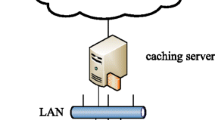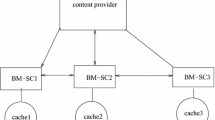Abstract
Partial caching of large media objects such as video files has been proposed recently as the caching of entire objects can easily exhaust the storage resources of a proxy server. In this paper the idea of segmenting video files into chunks and applying replacement decisions at the chunk level rather than on entire videos is examined. It is shown that a higher byte hit ratio (BHR) can be achieved by appropriately adjusting the replacement granularity. The price paid for the improved BHR performance is that the replacement algorithm takes a longer time to converge to the steady state BHR. For the segmentation of video into chunks two methods are presented. The Fixed Chunk Size segmentation scheme that is rather simple and reveals the basic trade-off between byte hit ratio (BHR) and responsiveness to changes of popularity; the Variable Chunk Size segmentation scheme that uses the request frequencies to dynamically adjust the size of the chunk and is shown to be capable of combining a small response time with high BHR. Moreover, a variation of the fixed chunk size segmentation scheme is presented, which is shown to improve its performance by switching between different chunk sizes. Video segmentation is also considered as a mechanism to provide for caching differentiation based on access costs. By employing access cost dependent chunk sizes an overall access cost reduction is demonstrated.
Similar content being viewed by others
References
S.A. Barnett, G.J. Anido and H.W. Beadle, Caching policies in a distributed video on-demand system, in: Australian Telecommunication Networks and Applications Conference, Sydney, Australia (1995).
J.-P. Nussbaumer, B.V. Patel, F. Schaffa and J.P.G. Sterbenz, Networking requirements for interactive video on demand, IEEE Journal on Selected Areas in Communications 13(5) (1995) 779–787.
C. Papadimitriou, S. Ramanathan, P. Venkat Rangan and S. Sampathkumar, Multimedia information caching for personalized video-on-demand, Computer Communications 18(3) (1995).
S. Sen, J. Rexford and D. Towsley, Proxy prefix caching for multimedia streams, in: Proceedings of the Conference on Computer Communications (IEEE Infocom), New York (March 1999).
Z.-L. Zhang, Y. Wang, D.H.C. Du and D. Su, Video staging: A proxy-server-based approach to end-to-end video delivery over wide-area networks, IEEE/ACM Transactions on Networking 8(4) (August 2000).
B. Wang, S. Sen, M. Adler and D. Towsley, Proxy-based distribution of streaming video over unicast/multicast connections, Technical report UMASS TR-2001-05, University of Massachusetts, Amherst (2001).
S. Ramesh, I. Rhee and K. Guo, Multicast with cache (mcache): An adaptive zero-delay video-on-demand service, in: Proceedings of the Conference on Computer Communications (IEEE Infocom), Anchorage, AK (April 2001).
S.-H.G. Chan and F.A. Tobagi, Caching schemes for distributed video services, in: Proceedings of the IEEE International Conference on Communications (IEEE ICC), Vancouver, Canada (June 1999).
M. Hofmann, T.S.E. Ng, K. Guo, P. Sanjoy and H. Zhang, Caching techniques for streaming multimedia over the Internet, Technical report, Bell Laboratories (May 1999).
J. Kangasharju, F. Hartanto, M. Reisslein and K.W. Ross, Distributing layered encoded video through caches, in: Proceedings of the Conference on Computer Communications (IEEE Infocom), Anchorage, AK (April 2001).
R. Rejaie, H. Yu, M. Handley and D. Estrin, Multimedia proxy caching mechanism for quality adaptive streaming applications in the Internet, in: Proceedings of the Conference on Computer Communications (IEEE Infocom), Tel Aviv, Israel (March 2000).
K.-L. Wu, P.S. Yu and J.L. Wolf, Segment-based proxy caching of multimedia streams, in: WWW 2001, Hong Kong, China (2001).
E. Balafoutis, A. Panagakis, N. Laoutaris and I. Stavrakakis, The impact of replacement granularity on video caching, in: Proceedings of IFIP Networking 2002, Pisa, Italy (May 2002) pp. 214–225.
D. Starobinski and D. Tse, Probabilistic methods for web caching, to appear in Performance Evaluation (Special Issue of SAPM 2000 Workshop).
L. Breslau, P. Cao, L. Fan, G. Phillips and S. Shenker, Web caching and Zipf-like distributions: Evidence and implications, in: Proceedings of the Conference on Computer Communications (IEEE Infocom), New York (1999).
B. Paul and C. Mark, Generating representative web workloads for network and server performance evaluation, in: Measurement and Modeling of Computer Systems (1998) pp. 151–160.
P.R. Jalenković, Asymptotic approximation of the move-to-front search cost distribution and least-recently-used caching fault probabilities, Annals of Applied Probability 9(2) (1999) 430–464.
Author information
Authors and Affiliations
Rights and permissions
About this article
Cite this article
Balafoutis, E., Panagakis, A., Laoutaris, N. et al. Study of the Impact of Replacement Granularity and Associated Strategies on Video Caching. Cluster Comput 8, 89–100 (2005). https://doi.org/10.1007/s10586-004-4439-2
Issue Date:
DOI: https://doi.org/10.1007/s10586-004-4439-2




